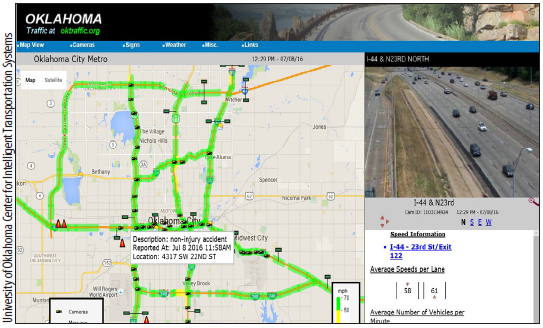You are here
Severe Weather Incident Management— Intelligent Transportation System Training Modules
The Southern Plains Transportation Center (SPTC) is a regional university transportation center focused on climate adaptive transportation and freight infrastructure. An active partner of the SPTC is the University of OklahomaCenter for Intelligent Transportation Systems (OU-CITS). OU-CITS was established in 1998 as the OU-ITS Lab—ajoint venture between the Oklahoma Department ofTransportation (ODOT) and the The University of OklahomaSchool of Electrical and Computer Engineering.
OU-CITS has assisted ODOT with the design and integration of Oklahoma’s statewide Intelligent Transportation System (ITS) since the beginning of that program. In cooperation with ODOT, OU-CITS implemented the first fully distributed, virtual traffic management center. OU-CITS members share their expertise by training transportation agents in ITS technology. OU-CITS also works closely with other transportation stakeholders, including the Oklahoma Department of Public Safety and municipal police agencies. Recently, OU-CITS collaborated across state agencies in the cooperative development of a traffic incident management system as part of the statewide implementation of the ITS (figure 1). Additionally, the collaboration has produced a related research project that involves using connected vehicle technology to improve traveler safety in inclement weather. The collaboration between the OU-CITS and the SPTC is, therefore, unique in that the collaborative projects range from pure research to real deployment of systems.
Product Development
The SPTC has facilitated and supported a collaborative effort between the OU-CITS, ODOT, and the U.S.DOT’s Traffic Safety Institute (TSI) in Oklahoma Cityto create training materials in the ITS area. Under theUSDOT’s training mission, the TSI provides multimodaltransportation safety training across the country. Thesemodules consist of three key ITS areas—passengervehicles, commercial vehicles, and transit—and will bedelivered nationwide through TSI training courses tailored to transportation professionals from Federal, State, andlocal government agencies as well as the private sector.
To date, the most significant product resulting from this collaboration is a case study entitled ITS in Severe Weather Incident Management. This case study ties closely to the SPTC’s focus on climate adaptive transportation and freight infrastructure. The SPTC, OU-CITS, and ODOT providedtheir domain expertise in developing this case study.
The ITS in Severe Weather Incident Management case study is based on the experiences of transportation agents from the May 2013 extreme weather events in Oklahoma. On May 19–20, 2013, Central Oklahoma was struck by a number of tornadoes, including an EF5 tornado that struck Moore, OK, on the afternoon of May 20. According to the Oklahoma Department of Emergency Management, this single tornado in the southern portion of the Oklahoma City Metropolitan Area killed 24 people and caused an estimated $2 billion in damages (figure 2).
Many of the challenges introduced in the case study were faced by transportation engineers in the early aftermath of the May 20th severe weather event. Highways wereblocked by damaged vehicles, and some ITS infrastructure was damaged or destroyed (figure 3). In addition to direct damage, electrical outages caused loss of power to several permanent ITS resources, and overloading of cellular networks caused communication difficulties.
The developed case study helps participants to familiarize themselves with ITS technologies and asks them to assume the role of a DOT engineering team as they respond to a major extreme weather event. Teams utilize permanentand portable Dynamic Message Signs (DMSs), Advanced Traveler Information Systems (ATIS, shown in figure 1), and other resources to inform motorists about safety hazards and reroute interstate highway traffic during and in the aftermath of a major extreme weather event. As part of the case study, these teams meet on a second day to discuss their response. One of the unique aspects of the ITS in Severe Weather Incident Management case study is a set of secret envelopes. These envelopes give team members their own set of unique and unexpected challenges and provide dynamic complications that transportation engineers may face in responding to disaster events—demonstrating the need for flexibility. While this study focuses on a tornado event, the challenges and approaches introduced are applicable to a variety of severe weather events, including flooding and hurricanes.
Product Implementation
The case study was tested by civil engineering students in their Transportation Engineering course in the spring of 2016. The participants provided strong and positive feedback on the effectiveness of the case study. It willnext be presented to engineers from ODOT’s Maintenance Division. In addition to the three ITS training modules, the SPTC and OU-CITS look forward to future opportunities to share their experience and expertise through collaboration with the TSI and the development of training materials. These modules are expected to enhance driver safety and have local, regional, and national impacts in the trainingof transportation professionals who manage severe weather incidents.
About This Project
This effort was led by Joseph Havlicek, Williams Presidential Professor in the School of Electrical and Computer Engineering and Director of the Oklahoma University Center for IntelligenUtTTrCansportation Systems and by Ronald Barnes, Gerald Tuma Presidential Associate Professor in the School of Electrical and Computer Engineering and Co-Director of the Oklahoma University Center for Intelligent Transportation Systems.
Inquiries may be sent to joebob@ou.edu or ron@ou.edu. The Southern Plains Transportation Center (SPTC) is a consortium of eight universities in U.S. Department of Transportation Region VI: the University of Oklahoma, Oklahoma State University, Langston University, University of Arkansas, University of New Mexico, Louisiana Tech University, University of Texas at El Paso and Texas Tech University.
This newsletter highlights some recent accomplishments and products from one University Transportation Center (UTC). The views presented are those of the authors and not necessarily the views of the Office of the Assistant Secretary for Research and Technology or the U.S. Department of Transportation.

Figure 1: Advanced Traveler Information System report of traffic incident to public.

Figure 2: Tornado Damage in Moore, Oklahoma.

Figure 3: Post-Tornado traffic, Moore, Oklahoma.
